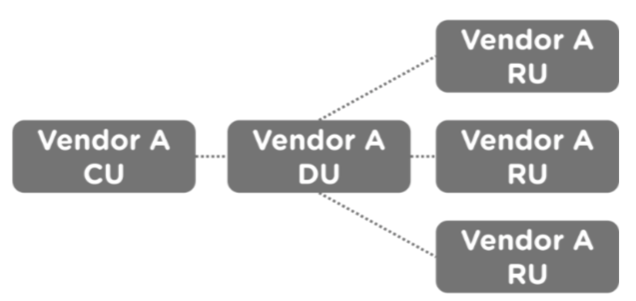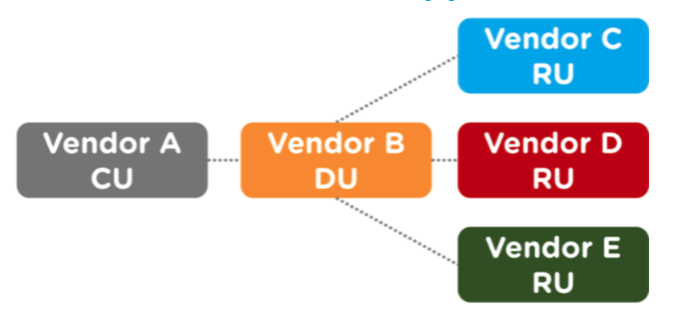What is Open RAN?
Too often, diving into the realm of Open RAN feels like plunging into a pool of technical jargon.
We understand the need for clarity without complexity. So, we’re taking a different approach.
Welcome to your simplified guide to Open RAN.
In essence, Open RAN is about breaking up traditional mobile networks into their individual components and making them ‘open’. This means allowing various vendors to provide parts of the system, promoting innovation and reducing costs.

Open RAN: What’s the deal?
Telecommunications is an industry that is constantly evolving – but Open RAN in particular stands out as a beacon for change. But what vision drives this change, and why is it resonating with industry leaders and innovators alike?
The primary vision behind Open RAN is to redefine the fundamentals of mobile networks. Traditionally, operators were bound to a single vendor, purchasing integrated systems that often lacked flexibility and adaptability. Open RAN revolutionises this approach by ‘opening up’ the radio access networks, allowing for greater interoperability and diversification.
Consider the inner workings of a laptop: you might find an Intel processor, a Samsung hard drive, and an Nvidia graphics card. This mix of competitive components has substantially driven down laptop prices over the years due to innovation spurred by competition. Now, imagine if a single vendor supplied every component of that laptop. While sourcing replacements might be straightforward, there’d be limited motivation for that one vendor to enhance processing speeds, improve display quality, or reduce costs. It’s a scenario few would tolerate.
So what does Open RAN aim to do to the telecom industry?
Flexibility & Innovation: By decoupling hardware from software, operators can mix and match components from different vendors. This not only fosters competition but also encourages technological advancements. An open environment breeds innovation, as multiple players contribute their unique solutions to enhance the ecosystem.
Cost Efficiency: Traditional network setups required hefty investments, with operators tied down to proprietary systems. Open RAN promises reduced capital and operational expenses. By breaking away from the one-size-fits-all model, operators can now select components based on both performance and cost-effectiveness.
Adaptability & Future-Proofing: As the demand for data grows and user requirements change, networks must evolve. Open RAN ensures that networks remain adaptable, ready to incorporate future technologies without extensive overhauls. The modular nature of Open RAN means that upgrades or replacements can be done component-wise, paving the way for a more sustainable and scalable network infrastructure.
In essence, the vision of Open RAN is to create a dynamic, collaborative, and competitive landscape in telecommunications. It’s about preparing for the future, ensuring that networks are robust, agile, and innovative. With Open RAN leading the charge, the telecommunications industry is poised to experience a paradigm shift, where collaboration and openness become the cornerstones of progress.
Governments worldwide are also casting their vote of confidence in Open RAN. Their backing often stems from a desire to diversify their telecommunication supply chains, reduce reliance on singular vendors, and boost national security. By fostering a diverse vendor ecosystem, Open RAN reduces the risks associated with dependency on a single provider, which can be vulnerable to geopolitical tensions or supply chain disruptions.
The diagrams below demonstrate a simplified view of a traditional network setup versus one that is Open RAN aligned.


Open RAN Aligned Solutions
Here’s Accelleran’s Open-RAN aligned multi-vendor solution as an example.
RU (Radio Unit): Think of the RU as the voice and ears of a network. It communicates directly with your mobile devices, handling the radio waves that transfer data. It’s that piece of equipment often seen atop cell towers. You can read more about Accelleran’s selection of Radio units here.
DU (Distributed Unit): DU’s task is to manage the workload for the RU. It prepares and organises data for the RU to send and receive. Consider it as the coordinator for the voice and ears (RU).
CU (Central Unit): CU serves as the brain of the operations, overseeing the broader aspects of managing the network. It decides how data should flow and ensures that the network runs smoothly.
RIC (RAN Intelligent Controller): This is where some ‘smartness’ enters our network. The RIC makes real-time decisions, using intelligence to optimise the network’s performance. Imagine having an advisor whispering suggestions to the brain (CU) for efficient functioning.
SMO (Service Management and Orchestration layer): As the name suggests, this layer orchestrates the entire system, ensuring each component works harmoniously with the others. Think of it as a conductor in an orchestra, making sure every instrument plays its part perfectly.
Open-RAN’s strength lies in its standardized interfaces, which allow diverse vendor equipment to communicate seamlessly.
- A1 Interface: This connects the RIC to the SMO, allowing for policy control and collecting data for intelligent decision-making.
- E1 Interface: Bridging the RIC and CU, the E1 interface provides a channel for real-time, fine-grained control of the RAN.
The adoption of standardised interfaces ensures that network components from different vendors can be integrated without compatibility issues. This flexibility fosters a competitive landscape, driving innovation and reducing costs.
Why Does Open RAN Matter
By opening up the network, Open RAN paves the way for a more flexible, efficient, and cost-effective communication infrastructure. Instead of one vendor locking down the entire system, different experts can bring their best to the table.
Open RAN is reshaping the way we think about mobile networks, ensuring a future where connectivity is more adaptable, innovative, and inclusive. Now, the next time someone asks, “What is Open RAN?” you’ve got a straightforward answer.
Would you like to know more?
Open RAN is no longer a concept limited to the lab, it’s already being deployed globally in a vast amount of use cases and industry verticals. If you’re keen to delve deeper and understand how Open RAN can revolutionise your operations or if you have queries about its implementation, get in touch with us. We’re always happy to answer any questions you may have.
